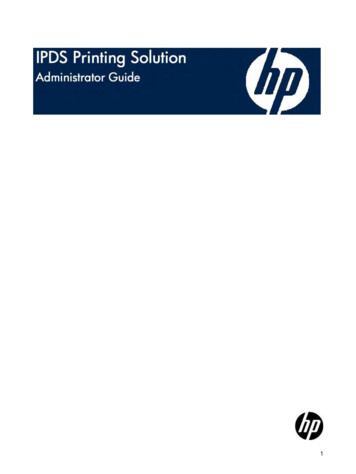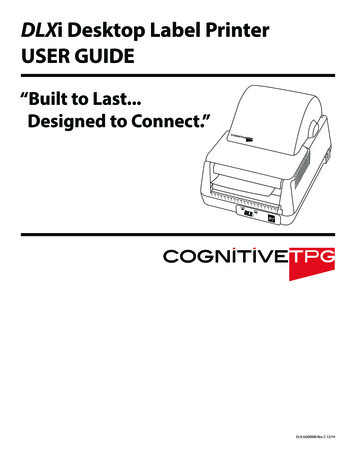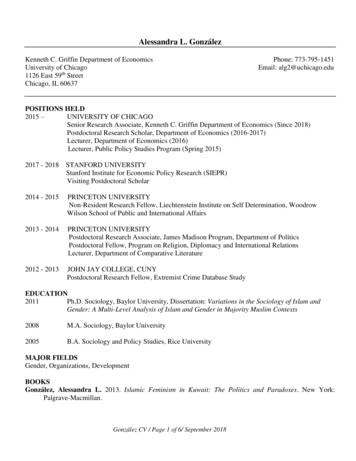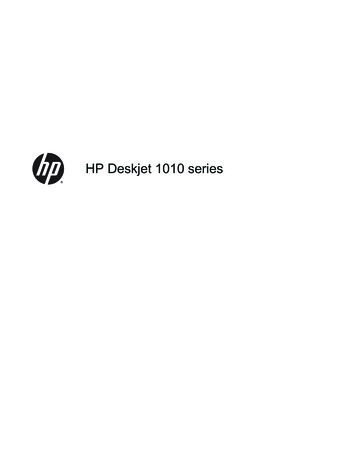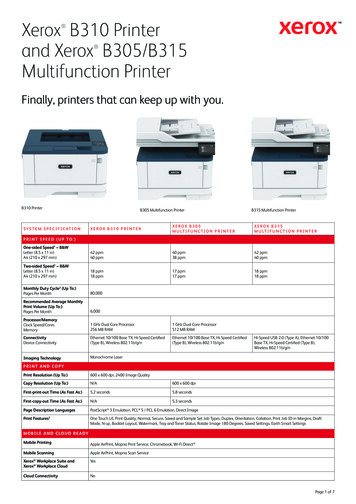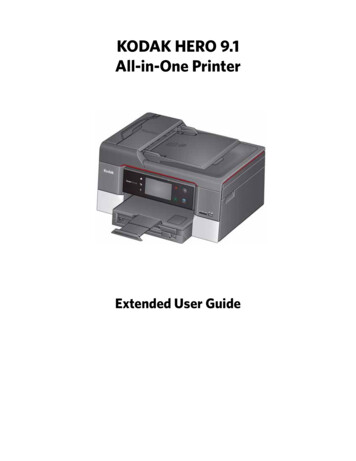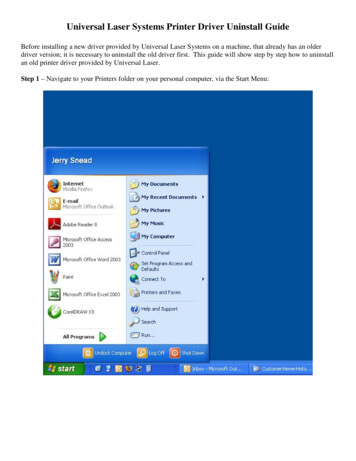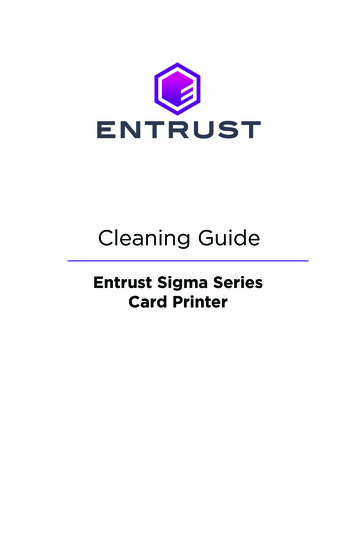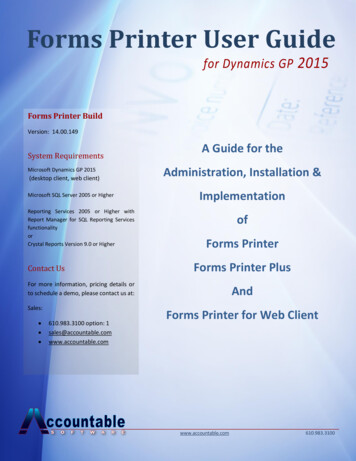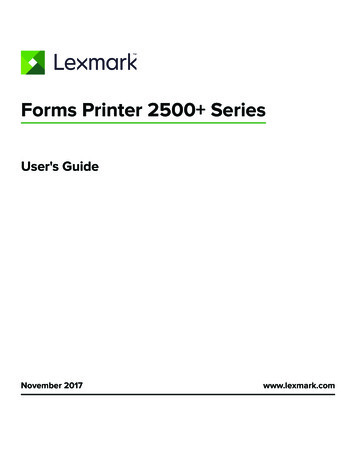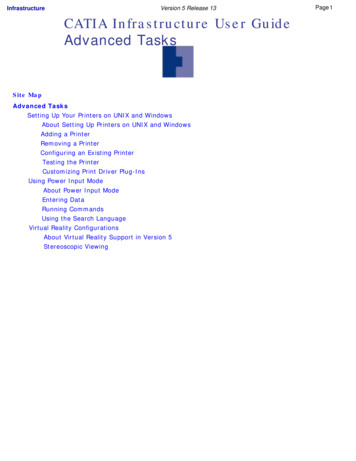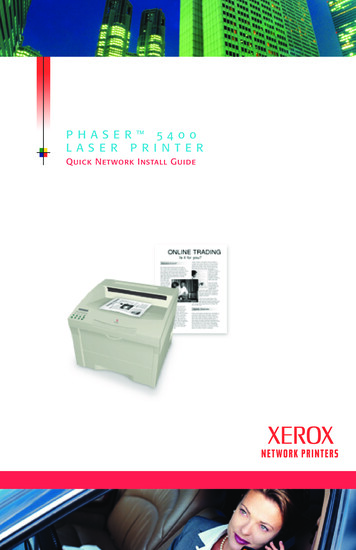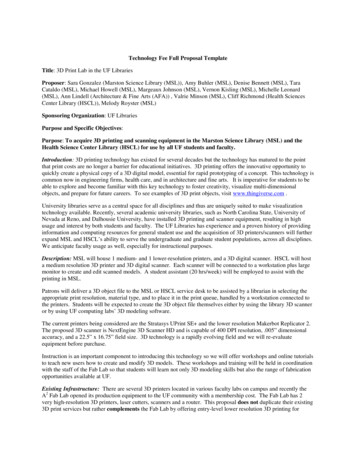
Transcription
Technology Fee Full Proposal TemplateTitle: 3D Print Lab in the UF LibrariesProposer: Sara Gonzalez (Marston Science Library (MSL)), Amy Buhler (MSL), Denise Bennett (MSL), TaraCataldo (MSL), Michael Howell (MSL), Margeaux Johnson (MSL), Vernon Kisling (MSL), Michelle Leonard(MSL), Ann Lindell (Architecture & Fine Arts (AFA)) , Valrie Minson (MSL), Cliff Richmond (Health SciencesCenter Library (HSCL)), Melody Royster (MSL)Sponsoring Organization: UF LibrariesPurpose and Specific Objectives:Purpose: To acquire 3D printing and scanning equipment in the Marston Science Library (MSL) and theHealth Science Center Library (HSCL) for use by all UF students and faculty.Introduction: 3D printing technology has existed for several decades but the technology has matured to the pointthat print costs are no longer a barrier for educational initiatives. 3D printing offers the innovative opportunity toquickly create a physical copy of a 3D digital model, essential for rapid prototyping of a concept. This technology iscommon now in engineering firms, health care, and in architecture and fine arts. It is imperative for students to beable to explore and become familiar with this key technology to foster creativity, visualize multi-dimensionalobjects, and prepare for future careers. To see examples of 3D print objects, visit www.thingiverse.com .University libraries serve as a central space for all disciplines and thus are uniquely suited to make visualizationtechnology available. Recently, several academic university libraries, such as North Carolina State, University ofNevada at Reno, and Dalhousie University, have installed 3D printing and scanner equipment, resulting in highusage and interest by both students and faculty. The UF Libraries has experience and a proven history of providinginformation and computing resources for general student use and the acquisition of 3D printers/scanners will furtherexpand MSL and HSCL’s ability to serve the undergraduate and graduate student populations, across all disciplines.We anticipate faculty usage as well, especially for instructional purposes.Description: MSL will house 1 medium- and 1 lower-resolution printers, and a 3D digital scanner. HSCL will hosta medium resolution 3D printer and 3D digital scanner. Each scanner will be connected to a workstation plus largemonitor to create and edit scanned models. A student assistant (20 hrs/week) will be employed to assist with theprinting in MSL.Patrons will deliver a 3D object file to the MSL or HSCL service desk to be assisted by a librarian in selecting theappropriate print resolution, material type, and to place it in the print queue, handled by a workstation connected tothe printers. Students will be expected to create the 3D object file themselves either by using the library 3D scanneror by using UF computing labs’ 3D modeling software.The current printers being considered are the Stratasys UPrint SE and the lower resolution Makerbot Replicator 2.The proposed 3D scanner is NextEngine 3D Scanner HD and is capable of 400 DPI resolution, .005” dimensionalaccuracy, and a 22.5” x 16.75” field size. 3D technology is a rapidly evolving field and we will re-evaluateequipment before purchase.Instruction is an important component to introducing this technology so we will offer workshops and online tutorialsto teach new users how to create and modify 3D models. These workshops and training will be held in coordinationwith the staff of the Fab Lab so that students will learn not only 3D modeling skills but also the range of fabricationopportunities available at UF.Existing Infrastructure: There are several 3D printers located in various faculty labs on campus and recently theA2 Fab Lab opened its production equipment to the UF community with a membership cost. The Fab Lab has 2very high-resolution 3D printers, laser cutters, scanners and a router. This proposal does not duplicate their existing3D print services but rather complements the Fab Lab by offering entry-level lower resolution 3D printing for
students who want to explore 3D printing for either class or personal use. Students who seek high resolution,production quality printing will be referred to the A2 Fab Lab.Impact/Benefit:The impact of these resources is potentially enormous since the 3D printers and scanners will be available for use bythe entire UF community. Based off our preliminary queries to departments, we anticipate that engineeringstudents will find it particularly useful, impacting almost 5000 undergraduates and almost 3000 graduatestudents. The equipment will also be highly visible to students, centrally located in the Marston Science and HealthScience Center Libraries. Both libraries have a high level of traffic, with over 705,000 students visiting MSL in2012.Students need the ability to create 3D models to rapidly turn an idea into a physical prototype. 3D printing alsoenables students to print out a representation of a concept (such as a molecule) and, by examining it tactilely ratherthan a 2D representation on a monitor, gain a better understanding of the object. Some potential uses at UF include: Anthropology: Replication of artifacts, skeletonsFigure 1: Artifact Replicas from 3D images printed in the 3D printer in the LSU Digital Imaging andVisualization in Archaeology (DIVA) lab, as well as the original artifact. (Photo courtesy H McKillop,Anthropology News, 2/6/2013) Architecture: Production of physical models of architectural structures Biological Sciences: Reconstruction of extinct organisms/fossils, production of genetic structures.Professor Monika Oli teaches MCB 2000L (800 students/semester) and plans to use the 3D resources forher instruction:“I am a faculty in Microbiology and Cell Science teaching microbiology labs. Over the last year I havebeen planning to use a 3d printer for several of our projects, but have not had the opportunity to work withsomeone who could help me with this. There are several projects I want to use the printer for with mystudents. 1. I want to produce 3D models of bacteria, parasites and viruses and study sub cellularorganelles. This will be used for the class and also for rotating exhibit in our building. 2. I amspearheading a project where I combine art and microbiology and am interested to use the printer for moreabstract - educational art - projects, which in turn can be used for outreach and K-12 education. We haveover 800 students per semester and the 3D printer would be a great way to introduce students to currentand cutting-edge- technology which is used in so many fields.”
Figure 2: Molecules, printed using Replicator (http://www.blog.csc.mrc.ac.uk/?p 184) Chemical Sciences: Production of molecular structures to better visualize interactions and complexities;production of custom lab equipment for specialized experiments. Civil and Coastal & Mechanical Engineering: Print structures to be tested inside UF’s wind tunnel;replicate lab equipment or mechanical parts, prototyping of custom pieces for undergraduate/graduateprojects Geography/Geospatial Sciences: Visualization of GIS and topographical data; modeling of watershedsFigure 3: 0.6 x 0.9 meter scale model of Seattle (http://www.rapidtoday.com/GIS-3D-Printing.html) Industrial & Systems Engineering: Dr. Keith Stanfill, director of the Integrated Product & Process DesignProgram, stated that “Our IPPD teams would be heavy users of this service” (125 studentsenrolled/semester). Health Sciences: Visualization of anatomical models; production of custom research equipment. The sixHSC colleges represent 6,900 students and approximately 1,129 residents.Figure 4: Anatomic Human Foot Model (http://www.thingiverse.com/thing:22628)
As students become more familiar with the technology, we anticipate the discovery of uses across all departmentsand disciplines. The UF Libraries have a librarian liaison for every UF department and we will reach out toinstructors to better integrate this technology into their coursework.Sustainability:The recurring costs will be sustained through print charges based upon the materials used. Replacement costs willbe based upon expected lifespan of equipment, annual maintenance and repairs. We are projecting usage basedupon statistics at other academic libraries and the feedback from UF course instructors. We are estimating 500 printjobs/semester for each printer of size 15 g (Replicator 2) and 2 in3 (UPrint SE ).Assuming a 3 year lifespan, annual maintenance costs (after the 1 year service plan) of 300/printer and usingcurrent prices for plastic, we will need to charge 0.25/gr and 7.10/in3 to sustain the 3D printers. For reference, astandard 2x4 Lego brick would cost 0.63 on the Replicator 2 or 2.09 on the higher resolution UPrint SE printer.Print charges will be evaluated semi-annually in order to address fluctuation in material costs and activity.Timeline:August 2013Funding awarded3D printers, scanners, monitors, computers orderedSignage, online tutorials createdSeptember 2013Equipment received, installed in MSL and HSCLStaff trained in equipment usageStudent hired to assist in printing and maintenance of equipmentOctober 20133D printing and scanning services beginWorkshops held and outreach to students and instructors beginOngoingStatistics on printer and scanner usage kept
Technology Fee Full Proposal TemplateTitle: 3D Printing and Scanning at the UF LibrariesProposer’s Name: Sara Gonzalez (Marston Science Library (MSL) ), Amy Buhler (MSL), Denise Bennett (MSL),Tara Cataldo (MSL), Michael Howell (MSL), Margeaux Johnson (MSL), Vernon Kisling (MSL), Michelle Leonard(MSL), Ann Lindell (Architecture & Fine Arts (AFA)) , Valrie Minson (MSL), Cliff Richmond (Health SciencesCenter Library (HSCL)), Melody Royster (MSL)BUDGETEquipmentQuantityCost per unitTotal CostUPrint SE 2 26,000 52,000Makerbot Replicator 2 (includes warranty,1 yr plastic filament)1 3,525 3,5253D NextEngine Scanner2 2995 5,990MultiDrive (aid in 3D modelcreation)2 995 1,990ScanStudio HD Pro (expandsprocessing to increase speed,higher detail)2 995 1,990RapidWorks (converts 3D scansto solid models)2 2995 5,9903 Year Extended Warranty2 295 590Workstations (Dell quote)OptiPlex 9010 Small Form Factor w/Standard PSU, Windows 7 Professional,No Media, 64-bit, English4 742.70 2970.80Dell UltraSharp U2412M 24-inchWidescreen Monitors with Dell MDS14Dual Monitor Stand4 739.49 2957.96NEC Large Monitor46" E462 Full HD LCD Display withTuner, Black2 684.88 1369.76TOTAL- 79,373.52
MSL will house 1 medium- and 1 lower-resolution printers, and a 3D digital scanner. HSCL will host a medium resolution 3D printer and 3D digital scanner. Each scanner will be connected to a workstation plus large monitor to create and edit scanned models. A student assistant (20 hrs/week) will be employed to assist with the printing in MSL.
